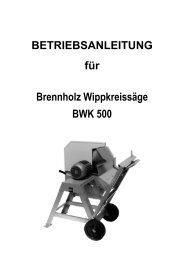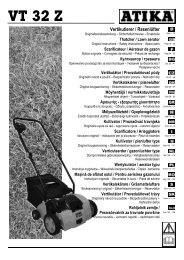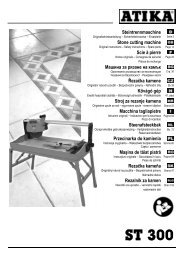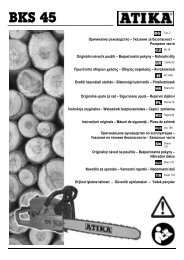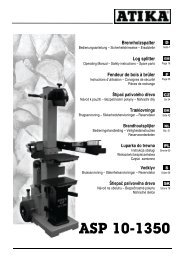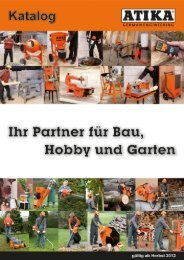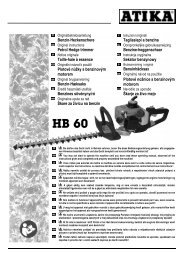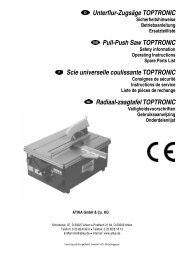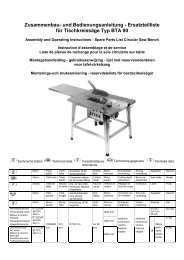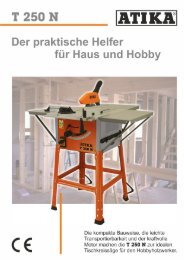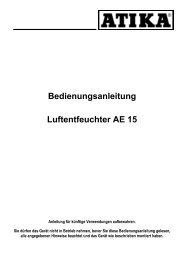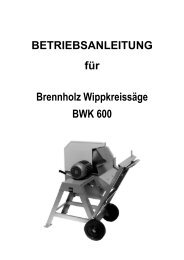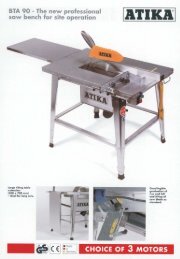Tischkreissäge ATS 250 Circular Saw Bench ATS 250 Scie - Atika
Tischkreissäge ATS 250 Circular Saw Bench ATS 250 Scie - Atika
Tischkreissäge ATS 250 Circular Saw Bench ATS 250 Scie - Atika
Sie wollen auch ein ePaper? Erhöhen Sie die Reichweite Ihrer Titel.
YUMPU macht aus Druck-PDFs automatisch weboptimierte ePaper, die Google liebt.
Before commissioning this product, read and keep to the<br />
following advice. Also observe the preventive regulations of<br />
your professional association and the safety provisions<br />
applicable in the respective country, in order to protect<br />
yourself and others from possible injury.<br />
�<br />
Pass the safety instructions on to all persons who work<br />
with the machine.<br />
� Keep these safety instructions in a safe place.<br />
� Avoid unusual posture. Ensure that you have stand in a<br />
secure standing position and maintain your balance at all<br />
times.<br />
� Be attentive. Be careful what you do. Behave sensibly<br />
when working. Do not use the saw if you are tired.<br />
� Wear suitable work clothes!<br />
− Do not wear loose-fitting clothes or jewellery; they can<br />
catch in moving parts.<br />
− Slip-proof shoes<br />
− Wear a hair-net if your hair is long<br />
� Wear protective clothing<br />
− Ear protection (sound pressure levels at the workplace<br />
usually exceed 85 dB(A)<br />
− Safety goggles<br />
− Breathing mask when carrying out works that produce a<br />
lot of dust<br />
� Only operate the circular saw on a<br />
− firm<br />
− level<br />
− slip-free<br />
− vibration free surface<br />
� Keep your workplace in an orderly condition! Untidiness<br />
can result in accidents.<br />
� Take into consideration environmental influences.<br />
− Do not expose the saw to rain<br />
− Do not use the saw in a damp or wet environment<br />
− Ensure that the workplace is well lit.<br />
− Do not use the saw near to flammable liquids or gases.<br />
− The timber dust created while operating the machine<br />
impairs the visibility required and is partially damaging<br />
to health. If the machine is not used in the open air, a<br />
shavings exhausts must be attached to both exhaust<br />
outlets (e.g. small transportable dust remover).<br />
� Never leave the saw unattended<br />
� Persons under the age of 18 must not operate the circular<br />
saw. An exception is youngsters under the age of 16<br />
within the scope of their vocational training under<br />
supervision<br />
� Keep other persons away<br />
Do not allow other persons, especially children, to touch<br />
the tool or cable.<br />
Keep them away from your working area.<br />
� Take up a working position, in which you are always to the<br />
side of the saw blade outside of the cutting level<br />
� Only begin cutting when the saw blade has reached the<br />
required speed<br />
12<br />
� Do not overload the machine! You work better and safer in<br />
the given performance range<br />
� Only operate the machine with complete and correctly<br />
attached safety equipment and do not alter anything on the<br />
machine that could impair the safety<br />
� Do not used cracked saw blades or those that have<br />
changed shape<br />
� Only use well sharpened saw blades, as blunt saw blades<br />
not only increase the risk of throw-back errors, but also<br />
load the motor<br />
� Do not use saw blades made of high-alloy high-speed<br />
tool steel (HSS), because this steel is hard and brittle, only<br />
tools in accordance with EN 847 – 1 may be used.<br />
The use of other tools and other accessories can<br />
signify a risk of injury for you.<br />
� Use the installed splitting wedge. It is set in the works so<br />
that its distance from the toothed ring above the table must<br />
not be more than 5 mm<br />
� Do not use the saw for unsuitable purposes (see 'Normal<br />
intended use').<br />
� When longitudinally cutting narrow workpieces (distance<br />
between the saw blade and the parallel rip fence less than<br />
120 mm), use the pushstick. (see working instructions)<br />
� To push narrow workpieces against the parallel rip fence,<br />
use a pushstick.<br />
Pushsticks can be purchased in retail outlets<br />
� Do not use defective pushsticks<br />
� The upper saw blade guard must always be used except for<br />
blind cuts. It must be adjusted so that the toothed ring is<br />
covered except for the part required for machining the<br />
workpiece<br />
� Ensure that cut off pieces are not caught up by the saw<br />
blade and projected away<br />
� Do not remove splinters, chips and waste from the<br />
hazardous area of the saw blade by hand<br />
� It is not permissible to use wobble devices and groove<br />
milling tools<br />
� Cutting logs with the standard feed guides is not permissible.<br />
When cutting logs, use a special device, which secures<br />
the workpiece on both sides of the saw blade against turning<br />
� Switch the machine off and remove the mains plug from<br />
the socket when<br />
− carrying out repair works<br />
− carrying out servicing and repair works, removal of faults<br />
(this also includes removing clamped splinters)<br />
− Transporting the saw<br />
− Changing the saw blade<br />
− leaving the saw unattended (even during short<br />
interruptions)<br />
� Look after your saw with care<br />
− Keep the tools sharp and clean to be able to work better<br />
and more safely<br />
− Follow the servicing instructions and the information<br />
about changing tools<br />
− Keep handles dry and free of oils and grease



